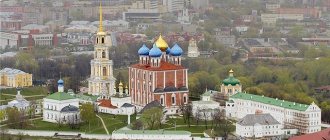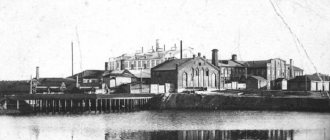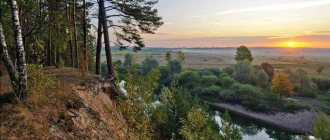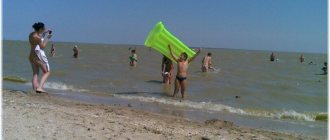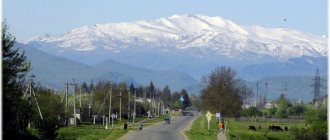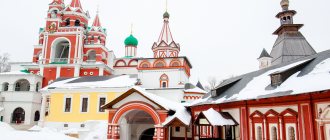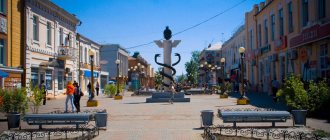The Kaluga region was included in the tourist “cashback” program. What is so interesting and amazing to see here? Why drive an hour from Tula or push through the car along the Kievskoye, Kaluga and Warsaw highways? Let's talk!
There are many interesting, beautiful, unusual and mysterious places in the Kaluga region. Natural and architectural monuments, national parks and museums. It’s impossible to list them all! Therefore, KGV, together with the tourism development department of the Kaluga region, have compiled for you the TOP 10 most interesting tourist places that travelers in Russia simply must visit in 2022!
Kaluga, State Museum of the History of Cosmonautics
Of course, next year, when the second stage finally opens to visitors, the museum will become twice as large and, accordingly, twice as interesting. But even now it is the first and largest space museum in the country, and in Kaluga it is the main museum of the regional capital. Unique exhibitions tell the story of the origin and development of means to overcome gravity and explore outer space. Having paid attention to the lunar rover, climbed aboard the life-size orbital station, and tasted the cosmic menu, you should definitely attend a session in the planetarium, where a unique apparatus operates that combines optical-mechanical and digital projections, which creates an indescribable feeling of being in space.
How to get there?
By car, by public transport
: Kaluga, st. Academician Koroleva, 2
Official site
Cities and villages
Kaluga
The city is located on the banks of the Oka. The road to Moscow is about 2 hours. The first mention of the city dates back to 1371.
Kaluga was rebuilt as a guard post on the way of foreigners to the Moscow state. Thanks to the Kaluga warriors, Tatar raids on Moscow were stopped. Events of the early 17th century. entered the history of the city as the Time of Troubles. False Dmitry I and II found refuge in Kaluga. A dark page in the history of the city was the invasion of Kaluga by the troops of Hetman Sagaidachny. The Zaporozhye Cossacks not only ravaged the city, but also practically destroyed its inhabitants.
In the middle of the 17th century. Most of the population died from the epidemic. The surviving 1000 people had to make considerable efforts so that already at the beginning of the 18th century. the city became a major trading center. In the 18th century Kaluga became deserted several times as a result of famine, severe fires, and plague. Catherine II played a decisive role in turning the city into a center for the development of trade and industry. Trade was carried out both with the cities of Russia and with England, China, Holland, etc. In the 18th century industrial production began.
Today, many monuments of architectural history have been preserved, testifying to the heyday of Kaluga. In the 19th-20th centuries. Industrial construction continued in the city. Much here is connected with the development of astronautics and the name of the outstanding scientist K. E. Tsiolkovsky. Here he made his most outstanding discoveries; his grave is in Kaluga.
Today in the city you can visit:
- State Museum of the History of Cosmonautics named after K. E. Tsiolkovsky. The world's first space museum was opened in 1967 with the personal participation of S.P. Korolev and Yu.A. Gagarin. In addition to the works of K. E. Tsiolkovsky, the museum presents in detail the entire history of the development of Russian cosmonautics. The pride of the museum is its modern planetarium model, thanks to which every visitor has the opportunity to take a “virtual” journey to the stars.
- Chambers of Korobovs. The building is an example of 17th century architecture. According to one legend, the treasures of Marina Mnishek, the wife of False Dmitrys I and II, are hidden in the secret basements of the building. Treasure hunters have been puzzled by their search for several centuries. The exposition of the local history museum is located here.
- Zolotarev's estate. The time of construction of the estate dates back to the 18th - early 19th centuries. There is an opinion among local historians that the estate was built for Catherine II and other high-ranking persons. The value of this estate lies in the original landscape details and interior items preserved in a single copy.
- The central city park of Culture and Recreation attracts vacationers not only with lush greenery - some protected specimens of trees are more than 600 years old - but also with historical monuments. In the depths of the park there is a voivode's hut, not far from it is the Trinity Cathedral - built in the 18th - early 19th centuries. The observation deck offers the best view of the Oka River in the city. The park has a dance floor, a brass band, and attractions.
Interesting facts and useful information about these and other attractions of Kaluga.
Borovsk
The date of foundation of the city is not known for certain. Artifacts found at the Borovsky settlement indicate the presence of a settlement in this place already in the 11th-13th centuries. The most ancient religious sites have survived to this day.
The city suffered greatly during the invasion of Napoleon's troops and fire in the 19th century. The city was actively upset in the 19th century. 20th century You can plunge into a bygone era while walking along the city streets. Among the architectural monuments one can highlight: the buildings of the Ezhekov factory, merchant houses with shops, the building of the city almshouse, the “lace” house of the Shokhinovs, etc.
The history of the city is connected with the name of K. Tsiolkovsky. Here he lived and taught for 12 years.
In the city you can see:
- Pafnutyevo-Borovsky Monastery. Its history begins in 1444 and is associated with the tragic events of the destruction of the Old Believers. In the monastery you can book a tour, during which the guide will tell you about the imprisonment of Archpriest Avvakum and the death of the noblewoman Morozova. If you wish, you can climb the bell tower, wander through the archimandrite’s chambers, and visit the Cathedral of the Nativity of the Virgin.
- Church of the Intercession of the Mother of God on Vysokoye. People come here not only to look at the wooden church built without a single nail. Near the temple there is a healing spring with fonts.
- Several Old Believer churches have been preserved in the city: the Vvedenskaya Old Believer Church, the All Saints Old Believer Church (it houses a museum and exhibition center), and the Cathedral of the Intercession of the Blessed Virgin Mary. City in the 17th century. became the center of the Old Believers. In it, Princess Urusova and noblewoman Morozova were martyred for their faith.
- Museum of the History of Borovsk. It displays the artistic works of fellow countrymen and tells about the history and traditions of the city. The exhibition includes authentic household items of the townspeople, and a collection of old photographs and maps.
- House-Museum of K. E. Tsiolkovsky. Tsiolkovsky lived in this house for more than 10 years. The real situation was recreated, the scientist’s original belongings were collected. The exhibition tells about the discoveries that were made by the scientist while living in Borovsk.
There is a separate article about Borovsk on our website, where these and other attractions are interestingly described.
Tarusa
The name of the city comes from the name of the Tarusa River. Slavic tribes settled on its banks starting from the 11th-12th centuries. The city was first mentioned in chronicles in 1246. Geographical proximity to the Moscow Principality predetermined the city's fate as a defense against foreign attacks. By the end of the 18th century. the city was almost completely burned down. By order of Empress Catherine II, the city was rebuilt according to a master plan that has survived to this day. By the end of the 19th century. The buildings in the city were predominantly wooden. The population was engaged in trade and crafts.
The nature of Tarusa inspired the work of the artist D. Polenov. He lived and worked near the city for several years. His canvases depict water meadows, Russian birches, etc. M. Tsvetaeva, K. G. Paustovsky, poet N. A. Zabolotsky, pianist S. T. Richter and many others came to Tarusa for a summer holiday. It is not for nothing that the city is called the Russian Barbizon (by analogy with the Parisian suburb, where the brilliant French created their masterpieces).
In Tarusa you can visit:
- Tarusa Art Gallery. A collection of Russian paintings and porcelain, arts and crafts items has been collected. The basis of the exhibition is the collection of N.P. Rakitsky donated to the museum. Thanks to him, you can admire the works of K. Bryullov, I. Aivazovsky, B. Kustodiev, M. Vrubel, A. Ostroumova-Lebedeva. The museum displays works by contemporaries and foreign masters.
- Tarusa Museum of Local Lore. The most ancient exhibits found during excavations are demonstrated. It tells about the history of the city, its traditions and the most striking events. Visitors are introduced to the biography of famous residents of Tarusa.
- Tarusa Museum of the Tsvetaev Family. Tells about the work of the famous poetess and the biography of her family. The museum hosts literary readings.
Read more about Tarusa and its interesting places
Obninsk
The first mention of the city dates back to the end of the 16th century. The city received its modern name in honor of its famous fellow countryman - writer V.P. Obninsky. The publicist described the events on the eve of the revolution and the life of the imperial family.
The nature of Obninsk is presented in the works of I. Levitan, V. Serovov, K. Korovin, V. Polenov and others. Dachas in the Obninsk region were photographed by musicians F. Chaliapin, N. Medtner, and poet V. Bryusov.
The modern history of the city is connected with the development of atomic physics and energy. The world's first nuclear power plant was built in the city, and there is a museum on its territory.
In the city you should visit:
- Museum of the History of Obninsk. It opened in 1965. The exhibits tell about the ancient history of small villages that later became part of the city. Household items of the population are presented, and the culture and traditions of the region are described. The central place of the exhibition is occupied by documents on the creation of secret scientific laboratories in the period 1940-1990. Today, there are 12 research institutes operating in the small town. The museum constantly displays an exhibition of paintings by famous and young Russian masters.
- Church of Boris and Gleb. Construction of the temple ended in 1773. After the 30s. 20th century a fertilizer warehouse was built here; almost nothing has survived from the artistic painting using the grisaille technique. The church building is traditional for the Catherine era. The restoration of the temple began in the late 80s. last century. An Orthodox library is open at the temple, and you can listen to the church choir.
There are many other interesting places in Obninsk; you can read about them in our guide to the city and its surroundings.
Maloyaroslavets
The settlement appeared on the site of the modern city in the 14th century. He was given a name in honor of the son of Prince Vladimir - Yaroslav. A monument was erected by contemporaries to the founder of the city, Prince Vladimir Donskoy.
The Russian army, under the command of Kutuzov, fought against the troops of Napoleon, gained fame in these places. A monument to the heroes of 1812 was erected in the city center. History buffs can learn about the battle and heroes of 1812 at the Military History Museum.
In the city you can visit:
- Nikolaevsky Chernoostrovsky monastery of the 14th century.
- Church of the Kazan Icon of the Mother of God. It was erected in 1708. At the beginning of the 20th century. destroyed. In n. 21st century restoration work has been carried out. Today the blue domes are visible from anywhere in the city.
That's not all, there are more interesting places with stories in the guide to Maloyaroslavets.
Museum-reserve "Polotnyany Zavod"
The most famous names of Russian history are intertwined in this space: Peter I, Catherine the Great, Kutuzov, Pushkin. Moreover, the reverent union of the Poet with the beautiful Natalya Goncharova made this place the most romantic in the entire region. A year ago, the museum-reserve entered the top ten favorite museums according to the results of an all-Russian online voting launched by the Ministry of Culture of the Russian Federation. The Goncharov House hosts theatrical excursions, noble balls, and opera evenings with metropolitan artists. After walking through the museum halls, you can go to the estate park, along the paths of which Pushkin walked, and paddle along Sukhodrevo. In one of the factory buildings there is the only paper museum in Russia, “Buzeon”, where you can not only learn everything about paper and how it is made, but also make a paper sheet with your own hands - as a keepsake of the Kaluga region.
How to get there?
By car – 36 km. from the center of Kaluga, by public transport from Kaluga
: Kaluga region, Dzerzhinsky district, Polotnyany plant, st. Trudovaya, 1A
3. Art Museum of Garbage "MU MU"
The first visitors to the museum were invited to evaluate the collection of 100 exhibits - even then the exhibition amazed the imagination. Now the museum has “increased its capacity” to 500 works of art made from garbage - from miniatures to giant installations! Along with the increase in the collection, people’s interest in the idea of the museum is growing - to draw attention to environmental problems and the need for reasonable consumption.
How to get there?
By car – 81 km. from Olkhovaya metro station along Kaluzhskoe highway.
: Kaluga region, Zhukovsky district, Grachi village, A-108, 41st kilometer
Avchurino
to the village of Avchurino because of the estate of the same name, built in two architectural styles: Empire and Neo-Gothic. More precisely, this is one of the surviving buildings of what was once a large manor complex. Its history and fate are extremely interesting.
The territory of the current estate was part of the line of the “coast” - the border fortifications of the Moscow principality on the border with Lithuania, which ran along the Oka. This fortification was headed by governors appointed by the prince, in particular, governor Vasily Ovtsa, after whose nickname, obviously, the territory got its name.
From the text of the “Kaluga tithe of residential buildings given to the church and empty church lands” it is clear that in the 17th century the Khitrovo and Yakovlevs served in these places. Avchurino appears under the designation “Yakovleva identity”.
In the 18th century, the estate was owned by Peter's associate Pavel Yaguzhinsky, whose first wife Anna Fedorovna came from the Khitrovo family. It is known that the emperor came here on a visit, for which an “oak avenue” was built.
After the Yaguzhinskys, Prince S.V. owned the estate for several decades. Gagarin. In the 1790s, Avchurino was bought by the Russian landowner Dmitry Markovich Poltoratsky.
The Poltoratsky estate became a cultural center - among its guests were the poet Nikolai Lvov, as well as the historiographer Nikolai Karamzin, who actively used the Avchurin library when working on “The History of the Russian State.”
Under the Poltoratskys, Emperor Alexander I visited here twice, who, traveling from Tula to Kaluga, stopped in Avchurino and inspected the farm, which he had previously heard a lot about and which was then considered exemplary.
After his death in 1818, the estate was inherited by his widow Anna Petrovna Poltoratskaya, ur. Khlebnikov, who continued her husband’s work, running the household under an English manager. She was also involved in arranging the estate, in particular, inviting Stasov and erecting a tomb at the church, where 8 years after her death the body of her late husband was transferred.
In 1832, Emperor Nicholas I visited the estate, and in 1837, during his trip to Russia, the 19-year-old heir-cresarevich, the future Emperor Alexander II, visited the estate together with his mentor, the poet Zhukovsky.
Poltoratsky and his descendants lived here until 1911, when the estate was acquired by another landowner Goncharov. Thus, the Poltoratskys owned the estate for 120 years.
According to the inventory of the 1840s, there were more than 50 buildings and structures in the estate. These included greenhouses, an equestrian arena, park pavilions, a bridge, and a huge cellar.
By the end of the 19th century, the estate had already begun to fade: “circumstances were such that it was impossible to maintain Avchurino at its previous height. Ruthless time destroyed everything, and the gradual sale of parts of the house did not save the situation. A large old wooden house from Catherine's time, facing the Oka River, burned down back in 1860.
In the 1890s, a huge barn and several wooden barns burned down; It was not possible to maintain the greenhouses and they were sold for scrap. The main house, a former library, was completely dilapidated and required major repairs; the outbuildings were aging and falling apart. The area of private farms was greatly reduced, and the lands were leased out to the peasants on depleting leases.”
After the revolution, the estate was nationalized. After 1917, a rest and study house was created here, where A. Chizhevsky, V. Yaroshevsky and others gave lectures. During the Great Patriotic War, many buildings were destroyed, but later restored. Source
The most amazing thing is that the building is not closed, but is used for different purposes. On one side is the entrance to the House of Culture, on the other is a functioning temple, and on the third is the Russian Post Office. It's a little dangerous to be inside. I hope that sooner or later the architectural landmark will be completely restored and turned into a worthy museum.
Art park "Nikola-Lenivets"
It seems unnecessary to tell what Nikola-Lenivets is - this landscape park is well known both in Russia and far abroad. The most whimsical images of the best architects from all over the world are embodied here - the map of the park contains more than 30 land art objects, many of which have become iconic for modern art. Nikola-Lenivets operates all year round: in summer it is most convenient to move around the territory by bicycle, in winter - on skis. The infrastructure of the park allows you to comfortably stay here for the whole weekend, there is a cafe, and after visiting the Kunsthalle, you can get a wooden souvenir made with your own hands.
How to get there?
By car – 69 km from Kaluga along the Kaluga-Medyn road.
: Kaluga region, Dzerzhinsky district, Nikolo-Lenivets village
Second day
We wander along eco-paths in search of hidden meanings and inner harmony.
Art park "Nikola-Lenivets"
How to get there
From “Ethnomir” we move along the highway through Borovsk towards Maloyaroslavets, then we go onto the Varshavskoe highway and after 35 km we turn left. Further along the highway to the village of Ostrozhny, there we also turn left - to the village of Nikola-Lenivets. The park is accessed by a dirt road with many potholes, and the fields and parking area become impassable in the rain. For the trip, it is better to choose dry weather or high rubber boots. It is important to book bicycles and overnight accommodations in advance, as they are few and far between.
Things to do
We wander in search of architectural metaphors through the fields and forests of Europe's largest art park. We look at the surroundings from the observation deck of “Bobur”, run across the field to the multi-door “Rotunda”, listen to the silence in “Nikolin’s Ear”, take dizzying pictures on the steep bank of the Ugra against the backdrop of the “Mayak”, and then go deeper into the thicket in search of the “Universal Mind” on the way to the "Border of the Empire". In total, on 650 hectares there are hundreds of installations and art objects created by artist Nikolai Polissky and his like-minded people from different countries. A leisurely, slightly mystical walk among objects of contemporary art evokes thoughts about new meanings of existence. For practical travelers, bicycle and canoe rentals are available. This territory of creative freedom often hosts large indoor festivals and exhibitions, so when planning a trip it is better to check the schedule, make sure that the park is open and buy tickets in advance.
An entrance ticket on the weekend will cost 400 rubles*. Allow at least five hours for your visit.
Ethnoworld
Cultural and educational introduces the traditional culture of different peoples of the world - through housing, clothing, food, crafts, and holidays. Here, a trip around the world is completed in one day. This is the largest ethnographic park in Russia. Each nation is assigned a kind of “cultural reserve” - an ethno-yard. A tourist can immerse himself in detail into the culture of the chosen people, or he can simply walk around, attending master classes from the keepers of traditions, participating in festival programs that are held here every weekend, visiting museums, of which there are an incredible number, even the “Museum of the Soviet School.” The ethnopark is developing dynamically, adding new objects, so that every time you can see something new.
How to get there?
By car – 9 km from Borovsk, 22 km from Balabanovo, 93 km. from Salaryevo metro station. By public transport from Borovsk.
: Kaluga region, Borovsky district, Petrovo village
Bird Park "Sparrows"
It all started with the first collection of birds in Russia, now there are animals, an exotarium, a tropical world, a harsh rock park, a pavilion with songbirds, the largest collection of parrots in Europe, and an ostrich farm. According to the magazine "Rest in Russia", the Kaluga Bird Park "Sparrows" is one of the ten best zoos and aquariums in the country. Tourists flock here to get acquainted with the world of birds: the park’s collection includes more than 270 species of birds. It’s better to go here with the whole family - it’s more fun to talk to a parrot, listen to a peacock sing, frown at eagles and vultures... And the total number of animals in the park, including animals, fish and amphibians, is more than 2,500 from all over the world.
How to get there?
By car – 72 km. from Olkhovaya metro station along Kaluzhskoe highway.
Address: Kaluga region, Zhukovsky district, village of State Farm Pobeda, st. Bird Park 3\1
Souvenirs
Savior Not Made by Hands deserts in c. Klykovo
Kaluga land is rich in master craftsmen. The city of Tarusa, located on the Oka River, is famous for its skilled embroiderers. Tarusa embroidery is made in red and white colors with the addition of yellow, green and blue. As a souvenir of their trip to the Kaluga region, tourists are happy to buy beautiful napkins, towels, oven mitts, dresses and tablecloths. Most of these items are machine embroidered, but textiles with elaborate hand embroidery can be found in gift shops.
Since the 19th century, the region has developed a craft for making clay toys. Khludnev whistles and figurines stand out with their bright colors and original painting. On them you can see intricate stripes, sun signs and diamonds. Nowadays, the secrets of making clay toys are held by craftsmen from the village of Khludnevo, the village of Duminichi and the city of Kaluga.
St. Nicholas Chernoostrovsky Convent in Maloyaroslavets
As delicious souvenirs from the Kaluga region they bring dark liqueur made in Kaluga, beautifully packaged Kaluga dough and fragrant curly gingerbreads. In addition, space-themed souvenirs are popular among travelers - original “space” nesting dolls, miniature models of the first spacecraft and gift books about space.
| ← RUSSIA | EUROPE → |
Museum G.K. Zhukova
Marshal of Victory Georgy Zhukov is a fellow countryman to every Kaluga resident. He was born in the small village of Strelkovka, now there, next to the peasant hut where the future commander grew up, an impressive monument has been built. And in the nearest town, which has been renamed Zhukov, there is the first museum in Russia of G.K. Zhukov with the most complete collection of his things. The visitor learns what the life of the man who accepted both the surrender of Nazi Germany in May 1945 and the first Victory Parade on Red Square was woven from. Many exhibits were transferred to the museum personally by Zhukov.
How to get there?
By car – 93 km. from Olkhovaya metro station along Kaluzhskoe highway.
: Kaluga region, Zhukovsky district, st. Sovestkaya, 1 and Strelkovka,
Natural attractions
Ugra National Park
Visitor center address: Kaluga, st. Lenina, 124 Phone: Opening hours: 9.00-18.00, closed on Monday Website: https://parkugra.ru/contacts/ Coordinates: 54.696893, 35.906937
The park was created to preserve the unique natural and historical landscapes of the Kaluga region. On its territory there are the remains of defensive structures of the 16-17th centuries, various temple and religious buildings, noble estates, military graves, etc.
Natural and cultural landscapes covering an area of more than 153.8 thousand hectares are under state protection. Within the park, accommodation is available in several tourist campsites. They are located in the following settlements: Sukovka, Ressa, Beldyagino, Papaevo, Mokroe, Natalinka, Pakhomovo, Lublinka, Valley of Love, Dretovo, Gordikovo. Accommodation in mini-hotels and ecological bases is possible.
Permission to visit the park must be obtained at the visitor center.
Damn town
Address: Ugra National Park. Eco-trail “Devil's Settlement”. How to get there from Kaluga: about 90 km along the P94 highway in the direction of Kozelsk. Further to the town of Sosensky, about 4 km on foot. Phone: (4842) 277-027 Coordinates: 54.075807, 36.035137
On the banks of the river Chertovskaya is formed by rocky outcroppings of sulfur quartz sandstone. An ancient settlement was discovered there. Archaeologists date it back to the 3rd-5th centuries. Artifacts dating back to the 9th-10th centuries were found. At this time, the upper reaches of the Oka began to be developed by the Slavs.
According to one version, the name of the settlement is associated with the characteristic depressions in the stones of natural origin. Another version is mythological.
The legend tells how Lyubushka outwitted the devil who planned to take her as his wife. The girl said that she would become the devil's wife if he built a huge stone castle. The devil called all the dark forces to help. Lyubushka lit up the night sky with a torch. The roosters woke up and began to crow. The evil spirits fled, and instead of a castle, the devil built walls with labyrinths and underground passages. He did not complete the task - the girl did not become his wife.
Tourists may be interested in the pentagonal well in the stones; the water in it is considered miraculous. The place is loved by ufologists who talk about temporary gaps in the settlement.
Rainbow Waterfall
How to get there from Kaluga: about 110 km in the direction of Obninsk, Papino village Coordinates: 55.211905, 36.954474
They say that the waterfall is especially beautiful in autumn: its waters reflect the bright foliage in all the colors of the rainbow.
From a height of 3-4 m, water descends from the cliff. There are several springs near the waterfall.
Koltsovo Caves
How to get from Kaluga: about 60 km to the village of Koltsovka, then 6 km to the Lyubovets ravine Coordinates: 54.426890, 36.647231
Abandoned since the 19th century. construction limestone was mined in adits. Carts moved freely in the caves of the adits. Horses carried stone blocks to the surface. After processing, the stone was carried down wooden chutes to the river directly to the barges.
The length of the underground passages reaches 800 m. Traces of the work of stonemasons are preserved on the walls, and nodules of crystalline gypsum are found.
Fans of mysteries claim that in the adits there are secret rooms of the warlock Count Vorontsov, who created an entire underground city here. There he practiced witchcraft. The legend was not confirmed by speleologists.
Museum-diorama “The Great Stand on the Ugra River in 1480”
There are many dioramas on the Kaluga tourist map, but this one is the largest and most spectacular of all. The museum was created on the very spot where one of the key events in Russian history took place - the Great Stand on the Ugra River in 1480, when, under the leadership of Grand Duke Ivan III, the united troops of Rus' put an end to the Mongol-Tatar yoke. Diorama made by masters of the Studio of Military Artists named after. Grekova, takes viewers half a millennium ago and conveys with reliable accuracy the picture of those historical days.
How to get there?
By car – 24 km. from the center of Kaluga. By public transport from Kaluga.
Address: Kaluga region, Dzerzhinsky district, village. Palaces, st. Tserkovnaya, 1
Churches, cathedrals and temples
Optina Pustyn
Address: Kozelsk Phone: Website: https://www.optina.ru/
The monastery was founded in the 15th century. The main temple is the cathedral of the Entry into the Temple of the Blessed Virgin Mary, around which churches are arranged in a cross pattern.
The monastery complex includes a skiff, where monks pray around the clock. Access for lay people is closed.
The monastery has a tragic history. In 1939, more than 5 thousand Polish prisoners of war were placed on its territory; during the Second World War, it housed a hospital and a testing and filtration camp.
In 1987, Optina wasteland was transferred to the Orthodox Church. The monastery is currently operational and has been completely restored.
In addition to the monastery, Kozelsk has a lot of interesting things - museums, ancient ruins, churches.
Chernoostrovsky Monastery
Address: st. Kutuzova, 2, Maloyaroslavets Phone: Website: https://stnikolamon.ru/
The history of the monastery began in the 14th century. from the construction of the Church of St. Nicholas in them. In the 17th-18th centuries. There was a small monastery here, in which several brothers labored.
In n. 19th century The monastery was upset thanks to the philanthropic activities of the merchant T. E. Tselibeev. Napoleon's troops caused great damage to the church.
There is a legend that during the battle an image of the Virgin Mary appeared in the sky. She showed Napoleon the way to the north with her hand. This is regarded as a harbinger of the death of the French army. It is also stated that an old man on a horse with a fiery sword appeared to our warriors. The fleeing French told with horror how Saint Nicholas helped the Russians.
The monastery was rebuilt again in AD. 20th century. Years of godlessness led to the plunder of the monastery. Its restoration began in the late 20th century. An orphanage has been opened at the monastery. Services are taking place.
Shamordino Monastery
Address: Kozelsky district, village. Shamordino Visiting hours: 8.00-20.00 Telephone:
The fifteen-domed cathedral was built in the Russian style at the end of the 19th century. After the revolution, the abbess of the monastery, in order to save it from complete ruin, asked to rename the monastery a labor commune. This delayed its disbandment for several years. Abbess Valentina did not see the destruction of the shrines and the painful death of the nuns - she died in 1919.
It can be considered a miracle that when a hospital was established on the territory of the monastery during the Second World War, not a single wounded person died. By the time the monastery returned to the jurisdiction of the Moscow Patriarchate, the monastery was destroyed.
The restoration of the monastery ended in 2005. All the stained glass windows and beaded frames were made by the hands of nuns.
On the territory of the complex there is a bathhouse at the “Life-Giving Spring”. In the refectory you can try monastery food.
St. Tikhon's Hermitage
Address: Dzerzhinsky district, village. Lev Tolstoy, st. Sovetskaya, 19 Phone: 8(48434) 4-43-11 Website: www.diorama-ugra.ru
The monastery was founded in the 15th century. Depending on its ownership, the deserts had different names: Maloyaroslavetskaya, Medynskaya, Kaluga. The monastery became famous for its healings at the holy spring and at the shrine of St. Tikhon.
At the beginning of the 20th century. There were 7 churches in the monastery. Believers especially revered the gigantic oak tree, in the hollow of which the Monk Tikhon performed his feat of solitude. In 1838, on the site of an oak tree broken by a thunderstorm in 1830, a chapel was built in which the remains of the tree were stored.
After the revolution, the monastery was plundered. Restoration began at the end of the 20th century. Currently there are 20 monks working in the monastery.
If you have not yet chosen where you will live and want to save money when booking, we recommend using the RoomGuru service. Firstly, it contains hotels, apartments and guest houses from many different booking systems, so you won’t miss out on a worthwhile option. Secondly, you can immediately compare prices for one place in different services and book where it is cheaper (this is not always Booking!).
Borovsk
Recently, among small towns in the region, it was Borovsk that took the palm of tourism championship from Tarusa. Located on the picturesque banks of the Protva River, ancient Borovsk tells its rich history in a completely unique way - with wall paintings, and this is not just an open-air gallery, but rather a city of parallel reality. To get into the spirit of Borovsk, after a walk you need to do two things: sit over aromatic tea on the veranda of the House of Happiness, inspired by the panoramic view opening from the site, and visit the Borovsk fortress - the Pafnutiev Monastery complex.
How to get there?
By car – 85 km. from Salaryevo metro station. By public transport from Balabanov.
Address: Kaluga region, Borovsk.
Ilyinsky line
This year is marked by special attention to the Ilyinsky frontier - a film created specifically for the 75th anniversary of the Victory is dedicated to this heroic story. The military-historical complex with a museum is located on the territory of a bloody battle - it was here in October 1941 that cadets of Podolsk military schools “at any cost” tried to delay the German army approaching Moscow. The filming took place very nearby - for this purpose, the filmmakers built a village and created a landscape that replicated the surroundings of Ilyinsky. The story of the “red cadets” is now told by several objects: a museum, a memorial, including anti-tank pillboxes preserved from the war, and the location of the Voenfilm film studio.
How to get there?
By car – 120 km: from the Salaryevo metro station along the Kievskoe highway to Obninsk, then along the Warsaw highway. By public transport from Maloyaroslavets.
